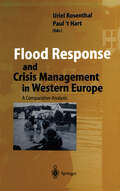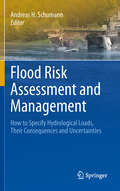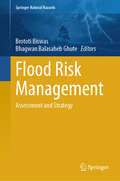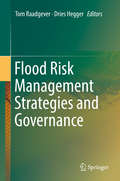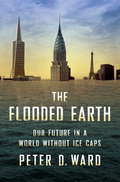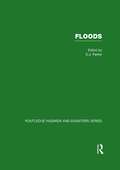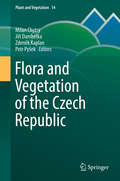- Table View
- List View
Flood Resources Utilization in the Yangtze River Basin
by Shouren Zheng Zhiyu Zhong Qiang Zou Yi Ding Lin Yang Xue LuoThis book is highly informative and carefully presented, providing scientific insights into the flood resources utilization in the Yangtze River Basin both for scholars and decision-makers. The book is for the purpose of analyzing the potential utilization of flood resources in the Yangtze River Basin and exploring effective ways to put forward the countermeasures against the risks. Major objectives of this book include: (1) revealing the characteristics of the inflow and the sediment variation in the upper reaches of the Yangtze River, quantitatively evaluating the potential utilization of the flood resources in the Yangtze River and demonstrating the feasibility of its utilization in the Basin; (2) proposing the necessity and feasibility of utilizing the flood resources by the Three Gorges Project; (3) shedding new light on the characteristics of the flood resources, presenting different methods of flood resources utilization in different regions over the Basin and raising the overall risk-optimized strategies of the flood resources utilization in the Yangtze River; (4) analyzing the risk of flood resources utilization for the Three Gorges Project regarding flood control, sediment, ecology, etc., and putting forward the risk-optimized countermeasures of flood resources utilization for the Three Gorges Project.
Flood Response and Crisis Management in Western Europe: A Comparative Analysis
by Professor Dr. DrThroughout the last 20 years, the study of disasters has developed into a well respected body of know ledge in the social sciences. Disaster research has found its way to several disciplines and it has been remarkably receptive to multi and interdisciplinary impulses. Many disaster studies show how important and stimulating it is to explore events and developments which reach beyond the usual business of the social and political fabric. There. is quite a difference between the daily routines of social and political life, and the upheaval, stress, and shock of a life-threatening danger which may fall upon society. Even when the danger does not materialize to the fullest and society gets off with a fright, the population as well as the authorities may experience demanding situations and critical moments which ask for an effective and quick response. Although the study of disasters is in steady progress, there still remains a lot to be done. One of the blind spots in disaster research continues to be cross national knowledge of disasters and disaster management. Certainly, during the last decade a number of encouraging efforts have been made to promote a more international perspective in disaster management. But as disasters and crises will increasingly feature transnational and even global characteristics, in that sense disaster and crisis research are lagging behind. Students of disasters and crises cannot limit themselves to typically domestic and local events.
Flood Risk and Community Resilience: An Interdisciplinary Approach (Earthscan Studies in Water Resource Management)
by Lindsey Jo McEwenThis book details the impact of flooding on our environment, and the ways in which communities, and those that work with them, can act to manage the associated risks.Flooding is an increasingly significant environmental hazard which inflicts major costs to the economies and livelihoods of developed countries. This book explores how local communities can identify, manage, and adapt to the ever-increasing damage flooding causes. Focusing on the future role of local communities, the benefits and challenges of their involvement, and the potential areas of transformation, this book provides insights into the efficacy of interdisciplinary and transdisciplinary working. Alongside research into similar environmental hazards, this book also draws upon the author’s own knowledge of flood risk management in distinctive non-contiguous interdisciplinary settings. The chapters draw together a different and distinctive set of interdisciplinary themes in flood risk management and social resilience. In doing so, it strives to communicate the different ways of thinking that can usefully contribute to flood risk management.This book would be ideal for those researching flood risk management, alongside scholars and non-scholars alike who are interested in finding ways of adapting to environmental hazards working with local communities.
Flood Risk and Community Resilience: An Interdisciplinary Approach (Earthscan Studies in Water Resource Management)
by Lindsey Jo McEwenThis book details the impact of flooding on our environment, and the ways in which communities, and those that work with them, can act to manage the associated risks.Flooding is an increasingly significant environmental hazard which inflicts major costs to the economies and livelihoods of developed countries. This book explores how local communities can identify, manage, and adapt to the ever-increasing damage flooding causes. Focusing on the future role of local communities, the benefits and challenges of their involvement, and the potential areas of transformation, this book provides insights into the efficacy of interdisciplinary and transdisciplinary working. Alongside research into similar environmental hazards, this book also draws upon the author’s own knowledge of flood risk management in distinctive non-contiguous interdisciplinary settings. The chapters draw together a different and distinctive set of interdisciplinary themes in flood risk management and social resilience. In doing so, it strives to communicate the different ways of thinking that can usefully contribute to flood risk management.This book would be ideal for those researching flood risk management, alongside scholars and non-scholars alike who are interested in finding ways of adapting to environmental hazards working with local communities.
Flood Risk Assessment and Management: How to Specify Hydrological Loads, Their Consequences and Uncertainties
by Andreas H. SchumannFlood catastrophes which happened world-wide have shown that it is not sufficient to characterize the hazard caused by the natural phenomenon "flood" with the well-known 3M-approach (measuring, mapping and modelling). Due to the recent shift in paradigms from a safety oriented approach to risk based planning it became necessary to consider the harmful impacts of hazards. The planning tasks changed from attempts to minimise hazards towards interventions to reduce exposure or susceptibility and nowadays to enhance the capacities to increase resilience. Scientific interest shifts more and more towards interdisciplinary approaches, which are needed to avoid disaster. This book deals with many aspects of flood risk management in a comprehensive way. As risks depend on hazard and vulnerabilities, not only geophysical tools for flood forecasting and planning are presented, but also socio-economic problems of flood management are discussed. Starting with precipitation and meteorological tools to its forecasting, hydrological models are described in their applications for operational flood forecasts, considering model uncertainties and their interactions with hydraulic and groundwater models. With regard to flood risk planning, regionalization aspects and the options to utilize historic floods are discussed. New hydrological tools for flood risk assessments for dams and reservoirs are presented. Problems and options to quantify socio-economic risks and how to consider them in multi-criteria assessments of flood risk planning are discussed. This book contributes to the contemporary efforts to reduce flood risk at the European scale. Using many real-world examples, it is useful for scientists and practitioners at different levels and with different interests.
Flood Risk in the Upper Vistula Basin (GeoPlanet: Earth and Planetary Sciences)
by Zbigniew W. Kundzewicz Markus Stoffel Tadeusz Niedźwiedź Bartłomiej WyżgaThis pioneering book addresses the entirety of river flooding issues in the Upper Vistula Basin, where considerable flood generation potential exists. It analyses the factors influencing flood risk, investigates variations in observation records and discusses projections for the future and adaptation to changing risk. It serves the general interest in understanding the floods that cause massive destruction in Europe, with dozens of fatalities and tremendous material damages. This interdisciplinary book, which covers aspects of climatology, geomorphology, hydrology, and water and flood risk management, unveils the complexity of the current situation. Access to reliable and accurate information can help solve important practical problems related to flood risk reduction strategies, and is at the core of the EU Floods Directive. As such, the book offers a valuable resource for scientists, educators and practitioners involved in water management, natural disaster reduction and adaptation to climate change.
Flood Risk Management: Assessment and Strategy (Springer Natural Hazards)
by Brototi Biswas Bhagwan Balasaheb GhuteThis book examines the nature of flood in different landscapes and the various factors that contribute to flooding in different areas. It identifies flood risk zones in different terrain types and provides valuable insights into the anthropogenic, geographical, hydro-geological, and geomorphological aspects of flood-prone areas to achieve sustainable risk management. The book also explores the impact of avalanches, global warming, and flash floods in different settings where such types of flooding have become more common. In addition, the volume provides case studies to evaluate the impact of flooding in both natural and man-made environments. To better understand and manage floods, the book combines advanced geospatial tools and techniques with indigenous knowledge. Using machine learning and multiple-criteria decision analysis, the book provides an amalgamation of technology and indigenous knowledge to assess flood susceptibility. The book also includes strategies to manage flood risks and case studies that demonstrate best practices in flood risk management. The volume is a valuable resource for researchers, students, and policy makers to understand the causes of floods and their socio-economic impact in different areas.
Flood Risk Management: Hazards, Vulnerability and Mitigation Measures (Nato Science Series: IV: #67)
by Jochen Schanze Evzen Zeman Jiri MarsalekFloods are of increasing public concern world-wide due to increasing damages and unacceptably high numbers of injuries. Previous approaches of flood protection led to limited success especially during recent extreme events. Therefore, an integrated flood risk management is required which takes into consideration both the hydrometeorogical and the societal processes. Moreover, real effects of risk mitigation measures have to be critically assessed. The book draws a comprehensive picture of all these aspects and their interrelations. It furthermore provides a lot of detail on earth observation, flood hazard modelling, climate change, flood forecasting, modelling vulnerability, mitigation measures and the various dimensions of management strategies. In addition to local and regional results of science, engineering and social science investigations on modelling and management, transboundary co-operation of large river catchments are of interest. Based on this, the book is a valuable source of the state of the art in flood risk management but also covers future demands for research and practice in terms of flood issues.
Flood Risk Management in Europe: Innovation in Policy and Practice (Advances in Natural and Technological Hazards Research #25)
by Selina Begum Marcel J. F. Stive Jim W. HallThis valuable edition brings together 25 peer reviewed articles on technical, socio-economic, environmental and policy aspects of flood risk management. Some emerging technologies are presented and several future challenges are identified. Thus the book forms an excellent reference for the engineers, scientists, planners, policy-makers, researchers, insurance industry and all the practitioners involved in flood risk management.
Flood Risk Management Strategies and Governance
by Tom Raadgever Dries HeggerThis book points out why organisational or governance aspects are essential for implementing a broad and integrated flood risk management approach. It provides key conclusions on resilient, efficient and legitimate flood risk governance arrangements in vulnerable urban areas in Europe. These are translated into concrete recommendations and good practices that can give you new insights and inspire you to improve policies and practices. The book is a way of spreading the results of the EU 7th Framework Project STAR-FLOOD. The project investigated strategies for dealing with flood risks in 18 vulnerable urban regions in 6 European countries: England, Belgium, France, the Netherlands, Poland and Sweden. STAR-FLOOD focused on governance aspects, from a combined public administration and legal perspective.
Flood Warning, Forecasting and Emergency Response
by Kevin SeneRecent flood events in Europe, the USA and elsewhere have shown the devastating impact that flooding can have on people and property. Flood warning and forecasting systems provide a well-established way to help to reduce the effects of flooding by allowing people to be evacuated from areas at risk, and for measures to be taken to reduce damage to property. With sufficient warning, temporary defences (sandbags, flood gates etc) can also be installed, and river control structures operated to mitigate the effects of flooding. Many countries and local authorities now operate some form of flood warning system, and the underlying technology requires knowledge across a range of technical areas, including rainfall and tidal detection systems, river and coastal flood forecasting models, flood warning dissemination systems, and emergency response procedures. This book provides a comprehensive account of the flood forecasting, warning and emergency response process, including techniques for predicting the development of flood events, and for issuing appropriate warnings. Related topics, such as telemetry and information systems, and flood warning economics, are also discussed. For perhaps the first time, this book brings together in a single volume the many strands of this interesting multidisciplinary topic, and will serve as a reference for researchers, policy makers and engineers. The material on meteorological, hydrological and coastal modelling and monitoring may also be of interest to a wider audience.
The Flooded Earth: Our Future In a World Without Ice Caps
by Peter D. WardSea level rise will happen no matter what we do. Even if we stopped all carbon dioxide emissions today, the seas would rise one meter by 2050 and three meters by 2100. This-not drought, species extinction, or excessive heat waves-will be the most catastrophic effect of global warming. And it won't simply redraw our coastlines-agriculture, electrical and fiber optic systems, and shipping will be changed forever. As icebound regions melt, new sources of oil, gas, minerals, and arable land will be revealed, as will fierce geopolitical battles over who owns the rights to them.In The Flooded Earth, species extinction expert Peter Ward describes in intricate detail what our world will look like in 2050, 2100, 2300, and beyond-a blueprint for a foreseeable future. Ward also explains what politicians and policymakers around the world should be doing now to head off the worst consequences of an inevitable transformation.
Floods
by Dennis J. ParkerFloods occur in most parts of the world and range from being welcomed annual occurrences, to natural disasters which have countless physical and societal impacts. Floods presents the most comprehensive collection to date of new research, providing a rich body of theory and experience and drawing together contributions from over fifty leading international researchers in the field. An extensive range of case-studies covering major floods and regions prone to flooding worldwide are included.
Floods
by Dennis J. ParkerFloods occur in most parts of the world and range from being welcomed annual occurrences, to natural disasters which have countless physical and societal impacts. Floods presents the most comprehensive collection to date of new research, providing a rich body of theory and experience and drawing together contributions from over fifty leading international researchers in the field. An extensive range of case-studies covering major floods and regions prone to flooding worldwide are included.
Floods and Flood Management (Fluid Mechanics and Its Applications #15)
by A. SaulIn recent years there have been a number of catastrophic floods that have resulted in a tragic loss of life. These natural disasters highlight the need to further understand the occurrence phenomena, to improve forecasting techniques, and to develop procedures and contingency plans to minimise the flood impact. This volume contains contributions from the 3rd International Conference on Floods and Flood Management held in Florence in November 1992. The volume is timely and provides an important overview for engineers, scientists, managers and researchers of the latest developments in technology, analysis and management.
Floods and Landslides: Integrated Risk Assessment (Environmental Science and Engineering)
by ClaudioMargottini RiccardoCasaleA review of such natural disasters as floods and landslides, highlighting the possibility of safe and correct land planning and management by means of a global approach to territory. Since the events deriving from slope and fluvial dynamics are commonly triggered by the same factor, occur at the same time and are closely related, this book analyses floods and slope stability phenomena as different aspects of the same dynamic system: the drainage basin.
Floods and Long-Term Water-Level Changes in Medieval Hungary (Springer Water)
by Andrea KissThe book provides an overview of the floods and major hydrological changes that occurred in the medieval Hungarian kingdom (covering the majority of the Carpathian Basin) between 1000 and 1500 AD. The analysis was based on contemporary documentary evidence presented for the first time and the results of archaeological and scientific investigations. Beyond the evidence on individual flood events, the book includes a comprehensive overview of short-, medium-, and long-term changes detected in a hydrologically sensitive environment during the transition period between the Medieval Warm Period and the Little Ice Age. It also discusses the possible causes (including climate and human intervention) and the consequences for the physical and human environment, namely the related hydro-morphological changes, short- and long-term social response, and human perception issues.
Floods in a Megacity: Geospatial Techniques in Assessing Hazards, Risk and Vulnerability (Springer Geography)
by Ashraf DewanFlooding is one of the most devastating natural hazards in the world. Available records suggest that both flood frequency and severity are on the rise and this is likely to worsen in the context of climate change. As population, infrastructure and poverty grow rapidly in developing countries, particularly in urban agglomerations of 10 million people or more, floods could cause widespread devastation, economic damage and loss of life. Assessment of vulnerability and risk from naturally occurring phenomena is therefore imperative in order to achieve urban sustainability. This book uses geospatial techniques to evaluate hazards, risk and vulnerability at a metropolitan scale in a data-scarce country. An empirical study was performed using remote sensing, GIS and census data. This research offers a new approach to mapping population, infrastructures and communities at risk which can greatly contribute to the deeper understanding of flood disasters in a rapidly expanding megacity. Examples shown in this book are from Dhaka Megacity, however, the techniques and methods can easily be implemented in medium to large cities of similar characteristics. The book is essential reading for hazard researchers, geospatial scientists, disaster management professionals, geographers, urban planners, and social scientists. Ashraf M. Dewan is currently a Lecturer in the Department of Spatial Sciences at Curtin University, Western Australia (on leave from his substantive position as Associate Professor in the Geography & Environment Department at the University of Dhaka, Bangladesh).
Floods of the Tiber in Ancient Rome (Ancient Society and History)
by Gregory S. AldreteWhile the remains of its massive aqueducts serve as tangible reminders of Rome’s efforts to control its supply of drinking water, there are scant physical reminders that other waters sometimes raged out of control. In fact, floods were simply a part of life in ancient Rome, where proximity to the Tiber left a substantial part of the city vulnerable to the river's occasional transgressions. Here, in the first book-length treatment of the impact of floods on an ancient city, Gregory S. Aldrete draws upon a diverse range of scientific and cultural data to develop a rich and detailed account of flooding in Rome throughout the classical period.Aldrete explores in detail the overflowing river’s destructive effects, drawing from ancient and modern written records and literary accounts, analyses of the topography and hydrology of the Tiber drainage basin, visible evidence on surviving structures, and the known engineering methods devised to limit the reach of rising water. He discusses the strategies the Romans employed to alleviate or prevent flooding, their social and religious attitudes toward floods, and how the threat of inundation influenced the development of the city's physical and economic landscapes.
Flora and Vegetation of Nepal (Plant and Vegetation #19)
by Maan Bahadur Rokaya Shalik Ram SigdelThis volume highlights the plant life of Nepal, which accounts for 20% of the Himalayan biodiversity. For the first time, this group of authors compile over 200 years’ worth of local botanical research. Due to the high topographical diversity, Nepal has a very unique flora and vegetation. The chapters focus on cryptogams, phanerogams and alien flora. As an added bonus, historical background for native and invasive species, is explained. Aside from botanical knowledge, the authors also shed a light on Nepali geography, soil, climate and land use. To complete the picture, readers will find data on different plants, maps and photographs of unique species. This book is a valuable resource for Botanists and Ecologists, but also for interested travelers who would like to complement their next trek in Nepal.
Flora and Vegetation of the Czech Republic (Plant and Vegetation #14)
by Milan Chytrý Jiří Danihelka Zdeněk Kaplan Petr PyšekThis book provides basic information on the botanical diversity in the Czech Republic and relates the patterns in flora and vegetation to environmental factors, biogeographical history and human impact. Focusing on vascular plants, bryophytes and lichens, it summarizes the data on taxonomic diversity and provides details of relict, endemic, rare, alien and other biogeographically important species. Main vegetation types are characterized in terms of their structure, distribution, ecology and dynamics, emphasizing the long-term vegetation changes since the late Pleistocene, historical impact of humans on vegetation and current changes in vegetation including the impact of alien species. Special attention is paid to the conservation of threatened plant species and their habitats and ecological restoration. An account of the history of botanical research in this country is also provided. The book is illustrated with numerous maps, graphs and photographs of plant species and communities. The book is an essential reference for any biogeographer, botanist and plant ecologist who is working in Central Europe or is searching for both general and more specific information on this part of the world.
Flora der Stadt Zürich: (1984-1998)
by Elias LandoltDie Flora der Stadt Zürich behandelt alle 1400 Arten der Farn- und Blütenpflanzen, die im Gebiet der Stadt Zürich vorkommen oder in den letzten 160 Jahren vorgekommen sind und sich hier selbständig vermehren. Darüber hinaus werden 600 zusätzliche Arten erfasst, die gelegentlich eingeschleppt oder sehr häufig kultiviert werden. Die angeführten 2000 Arten sind mit Strichzeichnungen illustriert und ökologisch charakterisiert. Ein übersichtlicher morphologischer Schlüssel ermöglicht die Bestimmung der Pflanzenarten. Für die 1400 einheimischen oder eingebürgerten Arten liegen Verbreitungskarten vor, auf denen auch frühere Vorkommen eingetragen sind. Anhand von Vergleichen mit Literaturangaben und Herbarbelegen werden die Entwicklung der Flora seit 1839 festgehalten und die Gründe für allfällige Veränderungen angegeben. Auch wenn die in der Flora enthaltenen Arten sich auf das Gebiet der Gemeinde Zürich beschränken, kann dieses Buch auf das gesamte Mittelland angewendet werden,...
Flora Fantastic: From Orchidelirium to Ecocritical Contemporary Art (ISSN)
by Corina L. Apostol Tashima ThomasThis book delves deep into colonial botany, utilizing mediums such as historical investigation, cinema, photography, live performance, and installation art.Surveying perspectives from Europe, the U.S., Africa, Southeast Asia, Latin America, and the Caribbean, it positions plants—both native and foreign—as active participants and silent observers in colonial narratives. By viewing through the prism of visual and performance art, this book touches on diverse topics like the economic value of plants, traditional and Western medicine, state‑endorsed scientific endeavors, migration patterns of flora and people, bio‑contact areas, nationalistic views, and botanical diplomacy. It offers fresh insights into colonial botany’s multifaceted history, emphasizing the intricate interplay between Eastern, Western, and Southern nations during the twentieth century and its enduring impact today.Serving as an invaluable addition to the realms of art history, performance studies, botany, visual culture, decolonial initiatives, and environmental politics, this book arrives at a pivotal moment when its insights are most crucial.
Flora Fantastic: From Orchidelirium to Ecocritical Contemporary Art (ISSN)
by Tashima Thomas Corina ApostolThis book delves deep into colonial botany, utilizing mediums such as historical investigation, cinema, photography, live performance, and installation art.Surveying perspectives from Europe, the U.S., Africa, Southeast Asia, Latin America, and the Caribbean, it positions plants—both native and foreign—as active participants and silent observers in colonial narratives. By viewing through the prism of visual and performance art, this book touches on diverse topics like the economic value of plants, traditional and Western medicine, state‑endorsed scientific endeavors, migration patterns of flora and people, bio‑contact areas, nationalistic views, and botanical diplomacy. It offers fresh insights into colonial botany’s multifaceted history, emphasizing the intricate interplay between Eastern, Western, and Southern nations during the twentieth century and its enduring impact today.Serving as an invaluable addition to the realms of art history, performance studies, botany, visual culture, decolonial initiatives, and environmental politics, this book arrives at a pivotal moment when its insights are most crucial.
Florida Manatees: Biology, Behavior, and Conservation
by John E. Reynolds IIIManatees, the gentle giants of Florida's lagoons and coastal habitats, can bring a smile to the face of anybody lucky enough to spy one. As manatees dip and roll through the water, crowds gather to watch them feed on aquatic vegetation. Whether they are congregating by the hundreds or resting or feeding alone, viewing these sea cows can provide anyone interested in nature with hours of tranquil pleasure.Having survived for eons, today's manatees are now under constant threat due to our rapidly swelling human population. Their habitats are often devastated by development and pollution. The slow-moving manatees also live at the mercy of chance, for they occupy waters filled with fast-moving boats powered by razor-sharp propellers;¢;‚¬;€?a new form of predator from which they have no protection. Boat speed limits have been put in place to protect manatees, but there is a constant push to lift them so that people can once again zip across the waters that manatees call home. For this reason, manatees are often a subject of controversy that pits their lives against the rights of boat owners. In this book, manatee expert John E. Reynolds III and famed photographer Wayne Lynch join forces to reveal the clearest portrait of manatees ever published. Florida Manatees is a song for the manatee, a celebration of the lives of these majestic creatures. Reynolds's concise, informative text shares what scientists know about manatees, while Lynch's beautiful photographs instantly demonstrate how special these "potatoes with whiskers" really are. By encouraging an appreciation of manatees, the authors hope to help ensure a future in which Floridians can find ways to coexist with and continue to enjoy these uniquely wonderful sirenian inhabitants of their state.Included in this book: How manatees first came to Florida waters How manatees fit into the ecosystems of Florida What and how much manatees eat How manatees behave and communicate with one another Why manatees look the way they do Why manatees have whiskers How manatee mothers feed their young and much more

